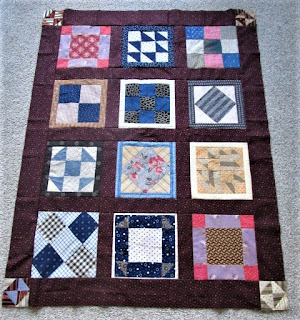The adventure began when, last fall, a friend called to encourage me to go to an estate sale in a barn out in the county. She said they were selling lots of needlework items, and she was right! The homeowner was definitely a crafty lady, into knitting, cross stitch, quilting, just to name a few! I found a few pieces of fabric and some notions, and as I was checking out and chatting with the relative of the deceased homeowner, I mentioned that I was a quilter. She said that there were several quilts still in the house that they weren't sure what to do with. I made arrangements with her to take a look at them one day the following week.
Most of the quilts had been well-used. They were not in very good condition...not something I would be interested in having for myself, so I gave her some ideas of others who might be. One quilt, however, caught my eye and I told her that it was worth saving somehow. That quilt was composed of beautifully embroidered flower blocks that I recognized as Ruby McKim designs. Something else that I noticed was that the embroidery was done on blocks cut from sugar or flour sacks...the printing was still visible on some of them! The quilt's label says that it was started in the 1930s and finished by the maker's daughter in 1998.
When the relative saw how excited I was about the quilt, she told me to take it and see what I could do with it. I envisioned reworking the quilt, preserving the embroidered blocks. As it was, the quilt was huge...40 embroidered blocks set with alternate print and white fabric squares. I knew it would be a big job to take it apart.
That job turned out to be even bigger than I had anticipated! The blocks had been joined quilt-as-you-go style, but SERGED!!! It took me many hours to take the quilt apart--my seam ripper got a workout! Another discovery was made once the blocks were separated and the batting removed--there was iron-on interfacing on the back of the embroidered blocks. Luckily that just seemed to easily peel off with no sticking or residue. So, how to clean and freshen up the embroidered blocks? Per Rebecca Haarer, purveyor of antique quilts in Shipshewana, OxyClean™ and Dawn™ were used. The blocks were soaked, hand washed, rinsed and laid out flat to dry. Most of the stains came out...some of the sugar sack printing became fainter, but still remained visible on many blocks.
At this point, the blocks were very wonky.
After pressing them, I was able to trim all but 3 of them to 7 1/2" square. To give them stability, I backed them with muslin quilt backing fabric which I cut to the same size and hand- basted around the block edges. I was asked to make small quilts for each of the quiltmaker's 3 granddaughters. Perfect! I had thirty six usable 7 1/2" blocks so 12 blocks would be used for each quilt. The smaller blocks were set aside to be made into matching pillows.
Solid green fabric was used for sashing and borders and each finished quilt top measures ~30" x 40". The quilt tops will be layered with cotton batting and muslin backing. Simple big stitch quilting and green binding will finish them off.
This project has turned into more than just preserving the blocks, however. As I worked with them, I had to know more about them! Ruby McKim designed several series of quilt blocks for publication in newspapers and I wanted to know the name of this series and exactly when it was published. In my collection of quilt ephemera, I have 3 newspaper cutouts from this series, which was titled "Flower Garden Quilt Patterns". The text that goes with the block images says that the series would contain 27 designs.
Searching the internet, I discovered the site https://mckimstudios.com and learned that this series was published in newspapers during 1929-1930. Obviously the maker of the quilt that I was working with clipped the designs as they were published and had a pretty complete set! The printing on the background of the embroidered squares also intrigued me! I could make out "Sparkling Crystal White" and what I thought said "Central Sugar Co." so I began another internet search. Between that search and asking Merikay Waldvogel for some help, I learned that there was a sugar beet processing factory in Decatur, IN, about 20 miles south of Fort Wayne (where we live)! It operated in the 1930s, so of course the quiltmaker would have access to sugar sacks for her needlework background fabric!
What a fun and interesting adventure it has been to continue work that was begun almost 100 years ago and to preserve that work for future generations of the family of the quiltmakers!









































